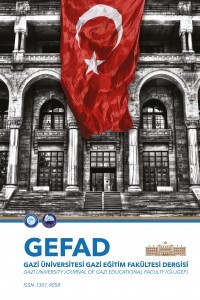Mobil Öğrenmeye Hazırbulunuşluk Ölçeğinin Uyarlanması: Geçerlik ve Güvenirlik Çalışması
Bu çalışmanın amacı, ”mobil öğrenmeye hazırbulunuşluk” ölçeğinin Türk kültürüne uyarlamasını yapmak ve psikometrik özelliklerini incelemektir. Araştırmanın örneklemini seçkisiz olmayan örnekleme yöntemlerinden uygun örnekleme yöntemi ile seçilen 165 kız ve 36 erkek olmak üzere toplam 201 katılımcı oluşturmaktadır. Veri analizinde; doğrulayıcı faktör analizi, Cronbach α, tabakalı Cronbach α ve McDonald ω katsayıları ve iki aşamalı kümeleme analizi kullanılarak ölçme aracına ilişkin güvenirlik ve geçerlik kanıtlarının toplanması ve standart belirleme çalışması yapılmıştır. Doğrulayıcı faktör analizi sonuçları incelendiğinde; GFI = 0.82, AGFI = 0.77, CFI = 0.95, NNFI = 0.91, RMSEA (%90GA) = 0.078 (0.067-0.090) ve SRMR = 0.082 olarak bulunmuş ve yapı geçerliğine ilişkin kanıtlar elde edilmiştir. Ölçeğin güvenirlik düzeyine ilişkin güvenirlik katsayıları incelendiğinde, mobil öğrenme öz yeterliliği, iyimserlik ve öz yönetimli öğrenme alt boyutları için sırasıyla Cronbach α değerleri; 0.889, 0.866 ve 0.860 iken McDonald ω değerleri; 0.943, 0.913 ve 0.857 olarak bulunmuştur. Ölçümlerin güvenirliği ve geçerliğine ilişkin kanıtlar toplandıktan sonra, iki aşamalı kümeleme analizi kullanılarak ölçme aracı için standart belirleme çalışması yapılmış ve kesme puanı 89.0 olarak elde edilmiştir. Sonuç olarak, mobil öğrenmeye hazırbulunuşluk ölçeğinin Türk kültürüne uyarlaması yapılmış ve psikometrik özellikleri incelenmiştir. İlgili ölçme aracı kullanılarak bireylerin mobil öğrenmeye hazırbulunuşluk düzeyleri belirlenerek, mobil öğrenmeye yönelik faaliyetlere yön verilebilir.
Anahtar Kelimeler:
Mobil Öğrenme, Hazırbulunuşluk, Geçerlik, Güvenirlik
___
- Bentler, P. M., & Chou, C. P. (1987). Practical issues in structural modeling. Sociological Methods & Research, 16(1), 78-117. https://doi.org/10.1177/0049124187016001004
- Brown, T. A. (2015). Confirmatory factor analysis for applied research. New York: Guilford Publications.
- Celik, V., & Yesilyurt, E. (2013). Attitudes to technology, perceived computer selfefficacy and computer anxiety as predictors of computer supported education. Computers & Education, 60(1), 148-158. https://doi.org/10.1016/j.compedu.2012.06.008
- Cheung, G. W., & Rensvold, R. B. (2002). Evaluating goodness-of-fit indexes for testing measurement invariance. Structural equation modeling, 9(2), 233-255. https://doi.org/10.1207/S15328007SEM0902_5
- Christensen, R., & Knezek, G. (2017). Readiness for integrating mobile learning in the classroom: Challenges, preferences and possibilities. Computers in Human Behavior, 76, 112-121. https://doi.org/10.1016/j.chb.2017.07.014
- Cochrane, T. (2014, June). Mobile social media as a catalyst for pedagogical change. In EdMedia+ Innovate Learning (pp. 2187-2200). Association for the Advancement of Computing in Education (AACE).
- Doolittle, P. E., & MaRIanO, G. J. (2008). Working memory capacity and mobile multimedia learning environments: Individual differences in learning while mobile. Journal of Educational Multimedia and Hypermedia, 17(4), 511-530.
- Hair, J.F., Black, B., Babin, B., Anderson, R.E. & Tatham, R.L. (2010), Multivariate data analysis. New Jersey: Prentice Hall.
- Hashemi, M., Azizinezhad, M., Najafi, V., & Nesari, A. J. (2011). What is mobile learning? Challenges and capabilities. Procedia-Social and Behavioral Sciences, 30, 2477-2481. https://doi.org/10.1016/j.sbspro.2011.10.483
- Hsin-Hui Lin, Shinjeng Lin, Ching-Hsuan Yeh, Yi-Shun Wang , (2016),"Measuring mobile learning readiness: scale development and validation", Internet Research, Vol. 26 Iss 1 pp. 265 – 287. https://doi.org/10.1108/IntR-10-2014-0241
- Kline, R. B. (2011). Principles and practice of structural equation modeling. New York: Guilford press.
- Lin, H. H., Lin, S., Yeh, C. H., & Wang, Y. S. (2016). Measuring mobile learning readiness: scale development and validation. Internet Research, 26(1), 265-287. https://doi.org/10.1108/IntR-10-2014-0241
- McVay, M. (2000). Developing a web-based distance student orientation to enhance student success in an online bachelor’s degree completion program. Unpublished practicum report presented to the Ed. D. Program, Nova Southeastern University, Florida.
- Osburn, H. G. (2000). Coefficient alpha and related internal consistency reliability coefficients. Psychological methods, 5(3), 343. http://dx.doi.org/10.1037/1082-989X.5.3.343
- Sha, L., Looi, C. K., Chen, W., Seow, P., & Wong, L. H. (2012). Recognizing and measuring self-regulated learning in a mobile learning environment. Computers in Human Behavior, 28(2), 718-728. https://doi.org/10.1016/j.chb.2011.11.019
- Sharples, M., Arnedillo-Sánchez, I., Milrad, M., & Vavoula, G. (2009). Mobile learning. In Technology-enhanced learning (pp. 233-249). Springer, Dordrecht. https://doi.org/10.1007/978-1-4020-9827-7_14
- Shih, J. L., Chuang, C. W., & Hwang, G. J. (2010). An inquiry-based mobile learning approach to enhancing social science learning effectiveness. Journal of Educational Technology & Society, 13(4), 50-62.
- Smith, P. J. (2001). Learners and their workplaces: Towards a strategic model of flexible delivery of training in the workplace. Journal of Vocational Education and Training, 53(4), 609–628. https://doi.org/10.1080/13636820100200180
- Smith, P. J., Murphy, K. L., & Mahoney, S. E. (2003). Towards identifying factors underlying readiness for online learning: An exploratory study. Distance education, 24(1), 57-67. https://doi.org/10.1080/01587910303043
- Traxler, J. (2005, June). Defining mobile learning. In IADIS International Conference Mobile Learning (pp. 261-266).
- Wang, Y. S., Wu, M. C., & Wang, H. Y. (2009). Investigating the determinants and age and gender differences in the acceptance of mobile learning. British journal of educational technology, 40(1), 92-118. https://doi.org/10.1111/j.1467-8535.2007.00809.x
- ISSN: 1301-9058
- Yayın Aralığı: Yılda 3 Sayı
- Başlangıç: 1985
- Yayıncı: Gazi Üniversitesi
